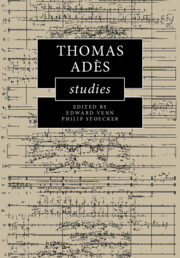Book contents
- Thomas Adès Studies
- Thomas Adès Studies
- Copyright page
- Dedication
- Contents
- Figures
- Tables
- Music Examples
- Online Materials
- Contributors
- Preface
- Acknowledgements
- Notes on the Text
- 1 ‘Chronically volatile’
- 2 Performing Adès
- 3 ‘Fountain of Youth’, ‘River of Meaning’
- 4 ‘Oh brave new Caliban’
- 5 Chaconnes in the Music of Adès
- 6 Closing the Circle?
- 7 A World in Constant Motion
- 8 Musique automatique? Adèsian Automata and the Logic of Disjuncture
- 9 Narrating the Dance of Death
- 10 Hearing Voices in Adès’s Operas
- 11 The RICH Logic of Adès’s The Exterminating Angel and The Tempest
- 12 Sonic Allegory in Adès’s The Exterminating Angel
- Bibliography
- Index
12 - Sonic Allegory in Adès’s The Exterminating Angel
Published online by Cambridge University Press: 18 November 2021
- Thomas Adès Studies
- Thomas Adès Studies
- Copyright page
- Dedication
- Contents
- Figures
- Tables
- Music Examples
- Online Materials
- Contributors
- Preface
- Acknowledgements
- Notes on the Text
- 1 ‘Chronically volatile’
- 2 Performing Adès
- 3 ‘Fountain of Youth’, ‘River of Meaning’
- 4 ‘Oh brave new Caliban’
- 5 Chaconnes in the Music of Adès
- 6 Closing the Circle?
- 7 A World in Constant Motion
- 8 Musique automatique? Adèsian Automata and the Logic of Disjuncture
- 9 Narrating the Dance of Death
- 10 Hearing Voices in Adès’s Operas
- 11 The RICH Logic of Adès’s The Exterminating Angel and The Tempest
- 12 Sonic Allegory in Adès’s The Exterminating Angel
- Bibliography
- Index
Summary
Drawing on Walter Benjamin’s theory of modern allegory, I argue that the narrative arc of The Exterminating Angel ushers in a spatiotemporal ‘collapse’ of diegetic time and slippage into ‘allegorical’ time. By distorting sonic elements (i.e. motives, cycles and topics), Adès establishes a musico-dramatic opposition in the course of the opera between false optimism and the eventuality of doom. This opposition translates into a battle between the socialites’ wilful interventions and the force that strips them of their will. In what I refer to as ‘allegorical’ time, the distinction between past, present and future dissolves, and the protagonists as well as the sonic elements are stripped of their identities and, by the end of the opera, disappear into an existential void. While the narrative trajectory follows the arc of dramatic irony, the conclusion of the opera defies resolution through the suspension of telos.
Keywords
- Type
- Chapter
- Information
- Thomas Adès Studies , pp. 258 - 282Publisher: Cambridge University PressPrint publication year: 2021
- 1
- Cited by

